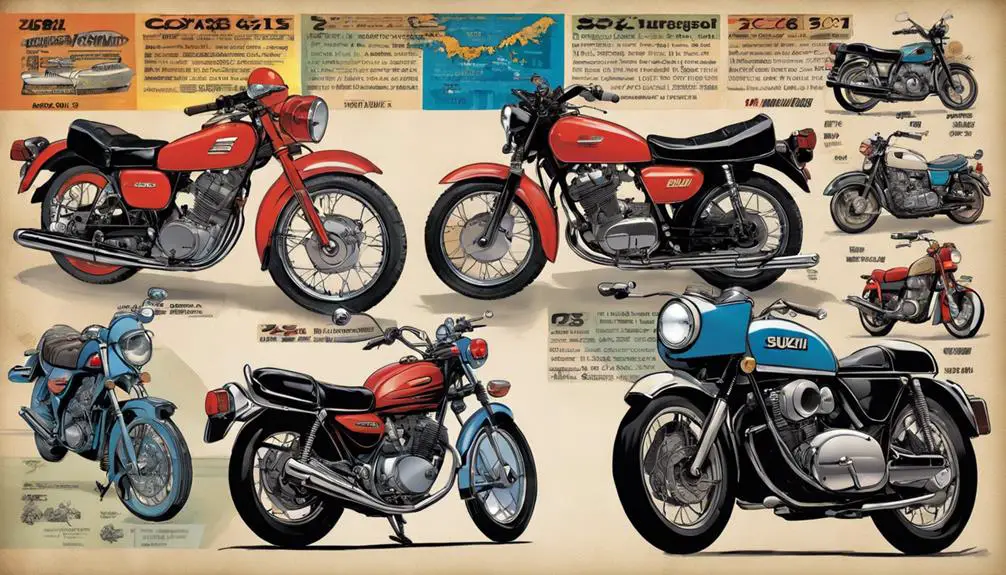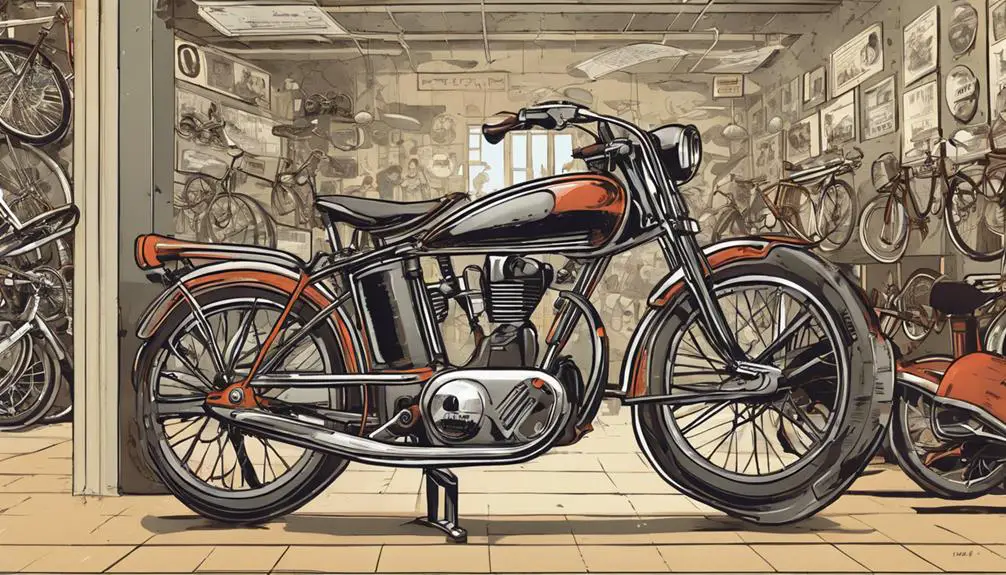When you think about bike performance, weight often plays a vital role, but have you considered how historical weight specs can inform your choices today? By examining the evolution of materials and iconic models, you can gain valuable insights into what makes a bike truly rideable. Understanding the nuances of weight distribution and its impact on handling is key, but there's more to explore. Let's take a closer look at some significant trends and tips that could change your approach to bike selection and performance.
Quick Takeaways
- Historical bike weight specifications have evolved from heavy steel frames to lightweight carbon fiber and titanium models, enhancing performance and agility.
- The 1980s introduced aluminum frames, significantly reducing bike weight without sacrificing strength, setting a new standard in cycling.
- Iconic lightweight bikes, such as the Trek Émonda and Specialized S-Works Tarmac, weigh around 14-15 pounds, ideal for climbing and performance.
- Heavier touring models like the Trek 520 and Surly Long Haul Trucker, weighing 30-32 pounds, provide stability and comfort for long-distance riding.
Evolution of Suzuki Motorcycle Weights

Suzuki motorcycles have undergone significant weight changes over the years, reflecting advancements in technology and design. You've likely noticed how lighter bikes can enhance your riding experience, providing that exhilarating freedom you crave. As engineers embraced new materials and innovative manufacturing techniques, they managed to shave off pounds while maintaining strength and durability.
You might remember the early models, which often felt cumbersome, limiting your ability to maneuver effortlessly. Today, Suzuki's commitment to reducing weight means you can navigate tight corners and open highways with ease. The focus on weight reduction isn't just about speed; it's about liberation. A lighter bike allows you to feel every curve of the road and every pulse of your engine, making each ride a true adventure.
As you explore the evolution of Suzuki motorcycles, you'll see how they've transformed not just in weight but in your connection to the ride. The journey from heavier models to the sleek, agile machines available today signifies a shift towards performance and freedom—something every rider desires.
Embrace this evolution, and let the open road call you to new adventures.
Key Weight Specifications Overview
Understanding key weight specifications is vital for selecting a motorcycle that fits your riding style and enhances your overall experience on the road. When you evaluate weight, think about how it impacts handling, performance, and comfort. A lighter bike typically offers better maneuverability, making it easier to navigate tight corners and urban environments.
Conversely, heavier motorcycles often provide stability at high speeds, which is essential for long-distance cruising. It's all about finding that balance that resonates with your sense of freedom.
Another important aspect is the distribution of weight. A well-balanced bike allows for smoother turns and more confidence on the road. You'll also want to take into account the weight of any additional gear or accessories you plan to carry.
When you're on the hunt for your ideal ride, pay attention to the specifications listed by manufacturers. They can provide insights into how various weight categories might affect your experience.
Ultimately, knowing these key specifications empowers you to make an informed choice, ensuring that every ride is a liberating adventure. So, embrace the journey, and let your bike reflect your spirit!
Notable Models and Their Weights

When you think of iconic lightweight bikes, several models come to mind that have set standards in performance.
On the flip side, heavyweight touring models offer durability and comfort for long rides.
Let's explore these notable bikes and their weights to see how they stack up against each other.
Iconic Lightweight Bikes
Some of the most iconic lightweight bikes have set benchmarks in the cycling world, showcasing impressive designs and remarkably low weights.
Take the Trek Émonda, for instance. Weighing in at just around 14 pounds, it's a climbing machine that gives you that exhilarating feeling of flying up hills.
Then there's the Specialized S-Works Tarmac, which weighs about 14.5 pounds but packs a punch in performance and responsiveness.
You might also consider the Cannondale SuperSix EVO. This ride, tipping the scales at approximately 14.8 pounds, is known for its crisp handling and speed.
If you're looking for a blend of weight and comfort, the Bianchi Oltre XR4, weighing about 15.5 pounds, will make your soul sing as you carve through corners.
Each of these bikes embodies liberation, allowing you to push your limits without being weighed down.
They remind you that cycling isn't just about the destination; it's about the freedom you feel on the open road.
Heavyweight Touring Models
Many touring bikes are designed with durability and comfort in mind, often resulting in heavier weights that enhance stability on long journeys. If you're considering a heavyweight touring model, you'll find some impressive options that can support your adventurous spirit while keeping you grounded on the road.
One notable model is the Trek 520, weighing in at around 30 pounds. This bike's robust steel frame and stable geometry make it perfect for carrying gear over long distances without compromising comfort.
Another popular choice is the Surly Long Haul Trucker, tipping the scales at about 32 pounds. Its versatility and rugged build mean it can handle both paved roads and rugged trails, liberating your journey from the confines of the predictable.
Lastly, the Kona Sutra, weighing approximately 30 pounds, offers a blend of comfort and durability, allowing you to tackle diverse terrains with confidence.
These heavyweight touring models might be a bit bulkier, but their solid construction and stability can empower you to explore, unshackling your wanderlust and enabling unforgettable experiences on two wheels. Choose wisely, and let the journey set you free!
Impact of Weight on Performance
When you consider a bike's weight, you're looking at how it affects acceleration and climbing ability. A lighter bike can make those steep hills feel less intimidating.
However, handling and stability also play essential roles in your ride's overall feel.
Let's explore how these factors impact your performance on the road or trail.
Acceleration and Climbing Ability
Weight plays an essential role in your bike's acceleration and climbing ability, directly affecting how quickly you can reach speed and tackle inclines. When you're on a lighter bike, you'll feel the freedom to accelerate faster, making it easier to respond to your environment, whether you're dodging traffic or racing against the clock. Every ounce counts; shedding unnecessary weight transforms your ride into an exhilarating experience, allowing you to release your full potential.
Climbing becomes less of a chore when you're not dragging extra weight uphill. A lighter bike means less effort is required, letting you conquer those steep grades with greater ease. You'll find that your stamina lasts longer, allowing you to push harder without feeling bogged down by excess mass.
Ultimately, choosing a bike with the right weight can liberate you, giving you the confidence to tackle any challenge the road throws your way. So, when you consider your next bike, remember—lightweight materials and design can elevate your performance, making every ride an adventure rather than a struggle. Embrace the liberation that comes with a bike built for speed and agility.
Handling and Stability Factors
A bike's weight also considerably influences its handling and stability, affecting how you navigate turns and maintain control at high speeds. Lighter bikes tend to feel more responsive and agile, allowing you to carve through corners with ease. You'll notice that as you lean into turns, a lighter frame encourages quicker adjustments, boosting your confidence on descents or tight corners.
On the flip side, heavier bikes can feel more planted, which might offer a sense of stability, especially at high speeds. However, this can also make them sluggish, requiring more effort to steer and maneuver. If you're chasing that liberating feeling on the open road, you'll want to find a balance that complements your riding style.
Consider how weight distribution plays a role too. A well-distributed weight can enhance your ability to maintain control, especially when going downhill or during sudden maneuvers.
Common Weight-Related Issues

Many riders encounter common weight-related issues that can affect performance and comfort on their bikes. You mightn't realize it, but the weight of your bike and its components plays an essential role in your riding experience. When you're aware of these issues, you can take steps to enhance your ride and embrace newfound freedom on two wheels.
Excessive Weight: A heavier bike can lead to fatigue, especially on long rides or steep climbs.
Weight Distribution: Improperly balanced weight can affect handling and agility, making your bike feel sluggish or unstable.
Component Choices: Heavy components can slow you down, while lighter alternatives may improve speed and responsiveness.
To tackle these weight-related challenges, consider your bike's overall setup and how it aligns with your riding style. You don't have to sacrifice comfort for performance. By making informed choices, like investing in lighter materials or adjusting your load, you can liberate your cycling experience.
Weight Trends Over the Decades
Over the decades, bike manufacturers have continuously innovated to reduce overall bike weight while enhancing performance and durability. This journey toward lightweight design has empowered you to experience freedom on two wheels like never before. From the heavy steel frames of the early 20th century to the sleek carbon fiber models of today, the trend has shifted dramatically.
In the 1980s, aluminum began to dominate, offering a significant weight reduction without sacrificing strength. As technology advanced, you saw the rise of exotic materials, like titanium and carbon fiber, which brought even lighter options to the market. These materials not only help you climb hills with ease but also create a nimbleness that lets you dance through city streets effortlessly.
Today, you benefit from a perfect blend of lightweight construction and advanced engineering. Manufacturers are fine-tuning every component, from wheels to handlebars, ensuring that you can chase your liberation on the road with minimal effort.
It's not just about shedding weight; it's about enhancing your connection to the ride, allowing you to explore the world around you with unmatched agility and freedom. Embrace this evolution and let your bike be a true extension of your adventurous spirit.
Tips for Evaluating Motorcycle Weight

When evaluating motorcycle weight, it's important to take into account how it impacts handling and performance on various terrains. A lighter bike can feel more nimble and responsive, while a heavier bike might provide stability but can be cumbersome.
Here are key factors to reflect on:
- Riding Style: Your preferred riding style—whether you're tearing through twisty mountain roads or cruising on highways—will influence how weight affects your experience.
- Terrain: Different terrains demand different weights. Off-road adventures often benefit from lighter bikes, while touring on highways might require a heavier, more stable ride.
Ultimately, finding the right motorcycle weight for you means balancing these factors to achieve the freedom you crave.
Don't just focus on numbers; take a test ride, feel the bike's balance in your hands, and trust your instincts. Embrace the journey and choose a motorcycle that truly resonates with your spirit of adventure.
Common Questions
How Does Rider Weight Affect Bike Performance?
Rider weight plays a vital role in bike performance. When you ride, your weight affects acceleration, climbing ability, and overall speed.
Heavier riders may struggle with steep inclines, while lighter riders often find it easier to zip up hills. However, if you're heavier, you can also generate more momentum, which can be advantageous on flat terrain.
Ultimately, it's about finding the right balance between your weight and the bike's design to enhance your riding experience.
Can Bike Weight Influence Insurance Costs?
When you think about the delicate dance between bike weight and insurance costs, it's like a featherlight breeze affecting your freedom ride.
Lighter bikes might lower the risk of theft or damage, potentially leading to lower premiums.
However, insurance companies often focus more on the bike's value and safety features than its weight.
What Tools Can Measure Motorcycle Weight Accurately?
To measure motorcycle weight accurately, you can use a few tools. A reliable digital scale or a weight bridge is ideal for precision.
If you're looking for portability, a compact motorcycle scale can also do the trick. Just roll your bike onto it, and you'll get an instant readout.
Always guarantee the surface is level to avoid inaccurate readings.
Knowing your bike's weight can empower your riding experience and maintenance choices.
Are Lighter Bikes Safer Than Heavier Ones?
Imagine riding a feather-light bicycle through a sun-drenched park, feeling the wind whip past you.
Lighter bikes often offer greater agility and responsiveness, which can enhance your control and maneuverability.
However, weight isn't the sole factor in safety; heavier bikes can provide stability and absorb shock better on rough terrain.
Ultimately, it's about the balance of weight, design, and your riding style that determines safety, not just the scale.
How Do Weight Specifications Impact Resale Value?
When you consider weight specifications, you're tapping into an essential factor that influences resale value.
Lighter bikes often attract more buyers since they're perceived as high-performance and easier to handle. If you decide to sell, potential buyers might pay a premium for that sleekness and efficiency.
On the flip side, heavier models may linger on the market longer, so keep weight in mind if you're looking to maximize your bike's resale potential.
Wrapping Up
In your quest for the perfect ride, remember that weight wisely wields power.
By understanding the evolution of bike weights, you can choose a model that matches your style and skill.
Don't just focus on figures; feel how the frame fits you.
Whether you prefer lightweight speedsters or stable touring bikes, finding the right balance transforms your cycling experience.
So, pedal with purpose, prioritize personal comfort, and let the journey guide your gear selection!